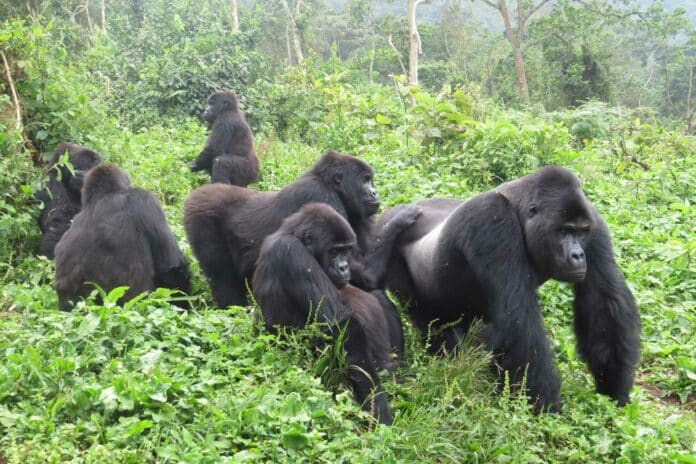Studying how gorillas interact with each other and form groups helps us understand their lives and can help us take care of them better. The GRACE center in the Democratic Republic of the Congo is a safe home for 14 Grauer’s gorillas, a type of gorilla that is in danger of disappearing.
By learning about their social relationships and how they live in groups, we can make better decisions to care for them, especially since they are critically endangered and need to be better studied.
A new study- published in PLOS ONE- monitored the association patterns of the gorillas at GRACE over eight months and described their individual relationships and group structure via multiple social network statistics.
Scientists observed how gorillas interacted with each other in three specific situations: during their morning search for food in ample outdoor space, when they moved from their forest area to their night shelters, and while making nests in their night shelters. They chose these situations because they provided regular opportunities for the caretakers (care staff) to watch the gorillas, and these activities were crucial parts of the gorillas’ daily routines.
By studying these contexts, researchers aimed to understand how the gorillas’ interactions were influenced by how they were taken care of and the group’s daily activities.
Data were collected over 32 weeks from early May 2022 through mid-December 2022 in three contexts: nesting, mixing yard, and forest enclosure shifting. Each gorilla dyad was recorded as being associated (within 1 m) or not for each context. Studies of gorilla associations in nature frequently utilize within 5m as their metric; however, recent research has highlighted that closer metrics provide more definition in association measures.
The high densities partially reflect the sanctuary environment such that the chances of being in proximity to a conspecific increased given they lived in a finite amount of space. The low association indices amongst individuals are similar to those reported between male-female mountain gorilla dyads within 2m in nature, suggesting the GRACE gorillas associate with one another similarly to mountain gorillas, their closest relatives. Association patterns of gorillas in zoos vary widely by study, making comparisons to our findings challenging.
This may reflect the diversity of group types, living spaces, and management procedures within zoos, and possibly because reporting association patterns in zoos is often focused on a specific applied perspective rather than a broad description of gorilla life in general.
Despite the weak association indices, up to a third of the dyads associated at rates more significant than the group mean, suggesting the gorillas did differentiate their relationships. In nature, the most robust association patterns amongst gorillas are observed between mothers and infants.
Even though the gorilla group was closely connected, the relationships between individual gorillas could have been stronger on average. Social network measures found that adult females were the most friendly and held a central position within the group. In fact, overall, adult females were the most sociable and socially central members. The patterns of associations within the group remained consistent throughout the eight-month study period, showing that the group was socially stable during this time across various types of observations.
The caregivers collected the information gathered in this study at GRACE as part of their everyday care routine for the gorilla group. This data offered valuable insights into the behavior of the gorillas, helping in making decisions about their care, well-being, and potential future release considerations. The methods used in this study can be easily adapted for use in any primate sanctuary or care facility.
Scientists noted, “Our study is the first social network analysis to be conducted on Grauer’s gorillas and provides tentative insights into the behavior of this poorly studied subspecies. Though more research is needed to evaluate if the findings here are reflective of this subspecies’ natural history or the idiosyncrasies of the group.”
Journal Reference:
- Austin Leeds, Dalmas Kakule, Laura Stalter, Jackson K. Mbeke, Katie Fawcett. Group structure and individual relationships of sanctuary-living Grauer’s gorillas (Gorilla beringei graueri). PLOS ONE. DOI: 10.1371/journal.pone.0295561
